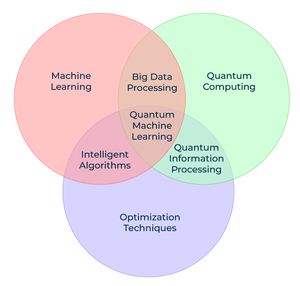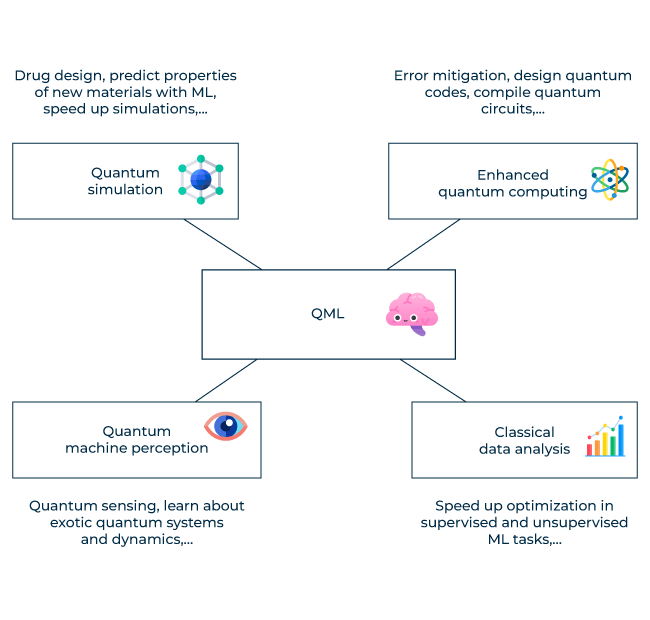Introduction to Quantum Machine Learning
Last Updated :
05 Dec, 2023
This article will provide you with more information about quantum computers, quantum machine learning, and potential future applications. The field of computer science is experiencing exponential growth in technology, with terms like Quantum Computing and Machine Learning being key terms in this regard. Have you ever wondered, though, what would happen if we combined modern machine learning and artificial intelligence with our understanding of the quantum world? How might it affect our technological systems? Is humanity going to benefit from it, or are we merely aiming blindly? Let’s first go over the fundamentals of quantum computing and its unexpected rules before getting into the specifics of this.
What is Quantum Machine Learning?
Quantum machine learning (QML) is an interdisciplinary field that integrates quantum physics concepts with machine learning to produce algorithms that employ quantum computer’s processing power to address specific sorts of issues more effectively than classical computers. The quantum computer, a whole new class of computing system, increases the hardware available for machine learning through quantum machine learning. Quantum theory, which is based on completely different physics, is the foundation for information processing using quantum computers.
The collaboration of machine learning, quantum computing, and intelligent optimization algorithms serves as the foundation for addressing the complexities of future communication systems and optimizing their performance.

Quantum Machine Learning
Quantum Mechanics
It is generally acknowledged that every element demonstrates both particle and wave properties, as numerous scientists have repeatedly demonstrated throughout history. Before being observed, a particle (such as an electron, photon, or other quantum entity) exists in every possible state in accordance with the laws of the quantum realm. We refer to this phenomenon as superposition. Schrodinger’s Cat experiment is one example of such a thought experiment. Despite its seeming absurdity, Schrodinger’s Cat is a real phenomenon. It’s crucial because, without the ability for quantum objects to exist in two states simultaneously, the computers you use would not be able to function.
Building Blocks for Quantum Computing
Our traditional computers use two-bit numbers 0 and 1. However, in the case of a Quantum computer, a bit can exist in a superposition of 0 and 1 with some probability of being 0 and some probability of being 1, which is referred to as Quantum bits or Qubits inspired by Quantum Mechanics laws. Classical physics governs humans, and we eventually live in a world represented by classical physical science (for anything larger than a molecule). As a result, the output must be classical – but measuring the values causes the qubit to lose its rationality and degrade into one of the potential states that a system can occupy. Quantum entanglement is the result of qubits interacting in a way that makes it impossible to determine a bit’s current state on its own without also knowing about other bits. To put it simply, each component depends on the other component as it stands at any given time. Large tech companies like Google, IBM, and NASA are already devoting significant financial resources to the development of quantum computing.
Machine Learning with Quantum Computing
Machine Learning is all about complicated mathematical calculations with large dimensions of data. Since a qubit can contain both 0 and 1 so we can say

So 1 qubit is 2 bits,2 qubit is 4 bits, 3 Qubit is 8 bits… and so on. Wait are you not impressed? Then let’s just imagine 300 Qubits which is 2^300 i.e 2^270 GB. We don’t even have that many atoms in the world(never underestimate the power of exponentials). Taking advantage of this classical data is converted into the Quantum data with dimensions reduced exponentially. Quantum data is any data source that occurs in a natural or artificial quantum system. Heuristic machine learning techniques can create models that maximize the extraction of useful classical information from noisy entangled data.
The TensorFlow Quantum (TFQ) library provides primitives for developing models that disentangle and generalise correlations in quantum data, allowing for the improvement of existing quantum algorithms as well as the discovery of new quantum algorithms. In addition, unlike classical computers, where a fixed input bit is sent to a logic gate module for some arithmetic operation and a corresponding fixed bit is obtained as output, quantum computers use quantum logic gates where the input is a superposition bit and the output is also an entangled superposition bit. In this process, the same input qubit can be manipulated to the various required outputs with varying entanglement in the logic gates, allowing us to find patterns and relations in the data more quickly. While performing the same task in a classical computer, and in some cases, supercomputers also can take very years to calculate because of limitations in the computation power. And that’s what machine learning is all about finding hidden patterns in the data.
Applications of Quantum Computing imposed with Machine Learning
Several uses for quantum computing in conjunction with machine learning include
- One of the most intriguing and potent subfields of machine learning is deep learning, which necessitates extensive matrix and linear multiplication. Massive matrix multiplication is necessary for neural networks, but loading the same onto a quantum logic gate is a non-trivial task that can be completed very quickly due to the quantum properties of the gate. This allows the multiplication of an exponentially large matrix with a similarly large vector.
- The design of pharmaceuticals and medical equipment, which is a laborious task even for supercomputers, can be impacted by quantum machine learning. This is because quantum machine learning necessitates the computationally challenging description and computation of every quantum property of an atom in a molecule. However, since a quantum computer uses the same properties, it performs better.
- Small-scale quantum computing combined with strong classical computing in a hybrid form for extremely large datasets (e.g., topological analysis).
- In order to prevent hackers from surreptitiously copying the key because of the uncertainty, quantum uncertainty can be combined with GANs for cybersecurity purposes to generate private keys for encrypting messages from one place to another.
- It may sound crazy, but there is a chance that we will be able to teleport information without actually sending it across space and time. This is possible because quantum particles have fluid identities that become entangled over time and space in such a way that altering one particle affects the other, ultimately forming a teleportation channel.

Key applications for QML
Quantum computers are a type of computer where the number of operations needed to reach a state is exponentially small, rather than where every operation will be faster. Thus, the increase is in the overall number of operations rather than the speed at which they are performed. They won’t be any faster for sending emails or watching YouTube videos, but rather for a specific kind of calculation where computational parallelism is seen. In summary, while the aforementioned ideas may seem implausible, we cannot rely solely on common sense when navigating the quantum world. Quantum computers are not more powerful versions of traditional computers, just as you cannot make a light bulb by increasing the power of candles. It’s an entirely new technology based on quantum mechanics that will undoubtedly boast machine learning million times over. Also, IBM provides access to the most advanced quantum computers for real-world work, so go ahead and try it out.
Uses of Quantum Machine Learning:
- Quantum data analysis: Big quantum datasets produced by quantum sensors or simulators can be analyzed using quantum machine learning. This might make it possible to analyze data more effectively and find patterns and insights more quickly.
- Quantum chemistry: Drug development and materials science benefit greatly from the ability to model and anticipate molecular behavior and chemical reactions through the use of quantum machine learning.
- Quantum optimization: Identifying the ideal configuration for a sizable system of interconnected components is one optimization problem that can be resolved using quantum machine learning. Supply chain management, scheduling, and logistics can all benefit from this.
- Quantum anomaly detection: When a quantum computer is being hacked, for example, anomalies in the system can be found using quantum machine learning.
- Quantum cryptography: The security of quantum cryptography systems can be increased by using quantum machine learning, for example, by identifying and blocking eavesdropping on quantum communication channels.
Issues in Quantum Machine Learning:
- Hardware limitations: In order to be used for machine learning applications in the real world, quantum computers still have a long way to go due to significant hardware limitations.
- Noise and error correction: The accuracy and dependability of quantum machine learning models may be adversely affected by the inherent noise and error-proneness of quantum systems. One of the biggest challenges in the field is creating efficient error correction techniques.
- Algorithm development: Considering quantum algorithms are fundamentally different from classical algorithms, developing effective and efficient quantum machine learning algorithms is a significant challenge.
- Data preparation: Designed data preparation techniques are necessary for quantum machine learning, and they can be difficult and time-consuming.
- Results interpretation: Since quantum machine learning models are based on states and processes that are fundamental to quantum mechanics and may be challenging to comprehend and visualize, they can be challenging to interpret.
- Scalability: Given that the resources needed to carry out quantum computations grow exponentially with the size of the problem, scaling up quantum machine learning models to handle big datasets and complicated problems is extremely difficult.
Frequently Asked Questions:
Q. 1 What is the concept of quantum AI?
Ans. Fundamentally, quantum AI builds upon the ideas of quantum computing and artificial intelligence to provide a system that is more robust and effective. Information is processed by conventional computers using bits, which can be either a 0 or a 1.
Q. 2 What is the objective of quantum machine learning?
Ans. QML is a technique of combining machine learning and quantum computing concepts, in which qubits are used instead of bits and the model is trained. QML can aid in the speeding up of existing algorithms, the development of new algorithms, and the solution of more complex algorithms.
Q. 3 What are the advantages of quantum ML?
Ans. Quantum machine learning employs the power of quantum computers to provide faster, more accurate computations as well as increased scalability. Because of the unique quantum properties, multiple solutions can be explored at the same time, resulting in more efficient problem-solving. Furthermore, quantum algorithms may reveal insights in data analysis that classical methods cannot.
Q. 4 What types of problems can QML address?
Ans. QML offers immense potential in solving data processing, pattern recognition, and optimization problems. In situations where classical methods have computational difficulties, quantum algorithms might perform better.
Share your thoughts in the comments
Please Login to comment...